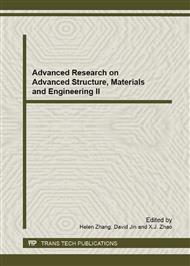p.85
p.89
p.93
p.98
p.103
p.107
p.111
p.119
p.123
Effect of Carbon Fiber Surface Structure on Hygroscopic Behavior for Composites
Abstract:
Carbon fibers with different surface structure are obtained by changing the level of anodization, and have the carbon fiber and epoxy resin processed into carbon fiber-resin matrix composite. Relationship between chemical structure of carbon fiber and moisture absorption property of composite in hot and humid environment is studied. The experiments show that the surface activity of carbon fiber increase significantly after anodization treatment, and there are a large amount of increase for oxygen-containing functional groups in fiber surface, in particular to OH which increase from 17.92% to 33.25%. The moisture absorption mechanism differs in varied conditions of heat and humidity, and temperature is an important factor affecting composites hygroscopic property. The higher the carbon surface activity is, the bigger the equilibrium absorbent moisture would be, and the increase of which would cause an obvious decline in inter-level shear strength (ILSS) value of carbon fiber-epoxy composites.
Info:
Periodical:
Pages:
103-106
Citation:
Online since:
May 2013
Price:
Сopyright:
© 2013 Trans Tech Publications Ltd. All Rights Reserved
Share:
Citation:


